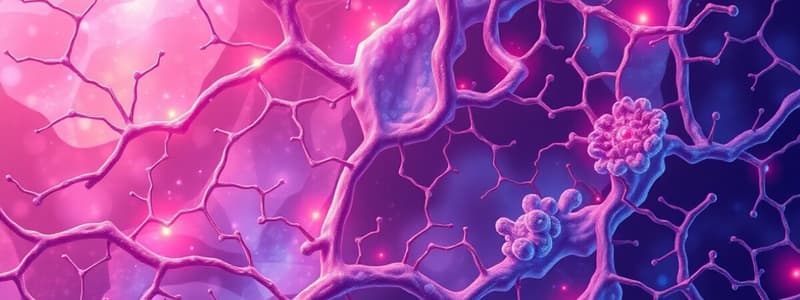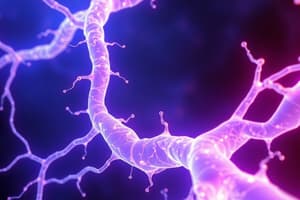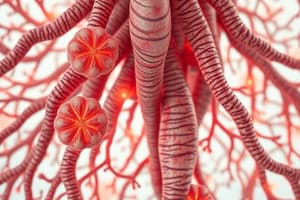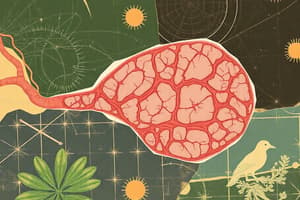Podcast
Questions and Answers
What is the primary origin of connective tissue?
What is the primary origin of connective tissue?
- Endoderm origin
- Mesenchymal origin (correct)
- Mesoderm origin
- Epithelial origin
Which component of connective tissue provides a medium for nutrient and waste exchange?
Which component of connective tissue provides a medium for nutrient and waste exchange?
- Extracellular matrix
- C.T. fibers
- Ground substance (correct)
- Cells
Which type of connective tissue fiber is known for its ability to provide elasticity?
Which type of connective tissue fiber is known for its ability to provide elasticity?
- Reticular fibers
- Elastic fibers (correct)
- Fibroblasts
- Collagen fibers
What characterizes fixed cells in connective tissue?
What characterizes fixed cells in connective tissue?
What is the primary function of connective tissue in terms of support?
What is the primary function of connective tissue in terms of support?
Which type of connective tissue is known for containing a large amount of extracellular matrix?
Which type of connective tissue is known for containing a large amount of extracellular matrix?
In which connective tissue type is the extracellular matrix described as firm?
In which connective tissue type is the extracellular matrix described as firm?
What role do wandering free cells primarily serve in connective tissue?
What role do wandering free cells primarily serve in connective tissue?
What is the function of adipose tissue in connective tissue?
What is the function of adipose tissue in connective tissue?
Which of the following is NOT a component of connective tissue?
Which of the following is NOT a component of connective tissue?
What is the main function of multilocular adipocytes (brown fat)?
What is the main function of multilocular adipocytes (brown fat)?
Which of the following best describes the origin of macrophages?
Which of the following best describes the origin of macrophages?
Which of these characteristics is NOT true for macrophages?
Which of these characteristics is NOT true for macrophages?
What type of cell are Langerhans cells classified as?
What type of cell are Langerhans cells classified as?
What structural feature is characteristic of reticular cells?
What structural feature is characteristic of reticular cells?
Which staining method is specifically used to identify reticular cells?
Which staining method is specifically used to identify reticular cells?
What do epithelioid cells represent?
What do epithelioid cells represent?
What role do macrophages play in the immune system?
What role do macrophages play in the immune system?
Which cell type in the mononuclear phagocytic system is found specifically in the liver?
Which cell type in the mononuclear phagocytic system is found specifically in the liver?
What is a key feature of brown adipocytes compared to white adipocytes?
What is a key feature of brown adipocytes compared to white adipocytes?
What is the primary function of undifferentiated mesenchymal cells (UMCs)?
What is the primary function of undifferentiated mesenchymal cells (UMCs)?
Which characteristic is NOT associated with fibroblasts?
Which characteristic is NOT associated with fibroblasts?
What role does the myofibroblast play in tissue response?
What role does the myofibroblast play in tissue response?
Which of the following cell types is responsible for filling spaces after tissue injury in non-dividing cells?
Which of the following cell types is responsible for filling spaces after tissue injury in non-dividing cells?
What is the shape and appearance of fibrocytes compared to fibroblasts?
What is the shape and appearance of fibrocytes compared to fibroblasts?
Which feature distinguishes unilocular adipocytes from other cell types?
Which feature distinguishes unilocular adipocytes from other cell types?
What happens to fibrocytes during adequate stimulation, particularly during wound healing?
What happens to fibrocytes during adequate stimulation, particularly during wound healing?
What is the appearance of fat cells in histological stains?
What is the appearance of fat cells in histological stains?
Which of the following cells is NOT directly involved in the formation of connective tissue?
Which of the following cells is NOT directly involved in the formation of connective tissue?
Which component is primarily formed by fibroblasts?
Which component is primarily formed by fibroblasts?
Flashcards are hidden until you start studying
Study Notes
Connective Tissue General Characteristics
- Originates from mesenchyme
- Contains cells, fibers (collagen, elastic, and reticular), and ground substance
- Cells are widely separated due to a large amount of extracellular substance (matrix)
- Matrix varies in consistency: firm in cartilage, hard in bone, and fluid in blood
- Some types are penetrated by blood vessels, lymphatics, and nerves
Functions of Connective Tissue
- Supports and connects cells, tissues, and organs
- Involved in healing injured tissues
- Provides resistance to stress, as seen in cartilage, bone, tendons, ligaments, and organ capsules
- Acts as a medium for exchange in blood, lymph, and connective tissue proper, delivering nutrients, waste products, and signaling molecules
- Plays a crucial role in immunity with plasma, mast cells, and white blood cells (WBCs) leaving the bloodstream and entering connective tissue proper for protection
- Involved in lipid storage and metabolism through adipose cells and adipose tissue
Connective Tissue Cells
-
Fixed Cells: Stable and long-lived cells
- Fibroblasts
- Fat cells (Unilocular and Multilocular Adipocytes)
- Undifferentiated Mesenchymal Cells (UMCs)
- Fixed Macrophages
-
Wandering Free Cells: Transient and migrate from blood to connective tissue
- Plasma cells
- Mast cells
- Leukocytes
Undifferentiated Mesenchymal Cells (UMCs)
- A multipotent stem cell
- LM: Small, irregular, branched, star-shaped, pale basophilic cytoplasm with a central large oval nucleus and visible nucleoli
- EM: Few organelles, many free ribosomes
- Function: Can differentiate into other connective tissue cells and give rise to blood cells in bone marrow
Fibroblasts
- Origin: UMCs, pericyte
- Sites: All types of connective tissue
- LM: Flat, branched, thin processes, oval nucleus with a prominent nucleolus, basophilic cytoplasm
- EM: Euchromatic nucleus, prominent nucleolus, RER, ribosomes, Golgi, mitochondria
- Function: Formation of connective tissue fibers, formation of ground substance, healing and repair of wounds
Fibrocytes and Myofibroblasts
- Fibrocytes (LM-EM): Smaller, spindle-shaped with few processes, elongated, dark nucleus
- **Myofibroblasts (LM-EM): ** Similar to fibroblasts and smooth muscle cells, containing actin and myosin.
- Function of Myofibroblasts: Responsible for wound closure
Fat Cells: Unilocular Adipocytes (White Fat)
- Sites: White adipose tissues
- LM: Rounded or oval, large cells with a peripheral flattened nucleus. Cytoplasm is pale and reduced to a thin rim around a large fat drop. Fat appears as large vacuoles in H&E staining (signet ring appearance). Stains orange with Sudan III
- EM: Fat drops appear as electron-dense inclusions, few cell organelles around the nucleus
- Function: Storage of fat, support organs, heat insulator
Fat Cells: Multilocular Adipocytes (Brown Fat)
- Sites: Brown adipose connective tissue
- LM: Small, rounded cells with a rounded nucleus and many small fat droplets. Contain many mitochondria, giving them a brown appearance
- Function: Heat generation
Macrophages
- Origin: Blood monocytes
- Site: Scattered in connective tissue or fixed to collagen fibers
- LM: Large branched cell with an irregular cell boundary (pseudopodia), dark kidney-shaped nucleus.
- EM: Pseudopodia, lysosomes, RER, Golgi
- Function: Phagocytic and antigen-presenting cells (APCs)
Mononuclear Phagocytic System
-
Macrophages present in different organs with various names:
- Von Kupffer cells in the liver
- Dust cells in the lung
- Langerhans cells in the skin
- Monocytes in blood
- Microglia in the brain
- Osteoclasts in bone
- Macrophages in the spleen, thymus, lymph nodes, bone marrow, and connective tissue
-
All have the same structure and function
Reticular Cells
- Origin: UMCs
- Site: Reticular stroma of parenchymatous organs (most common cell in reticular connective tissue)
- LM: Small, branched cell with many processes (reticular fibers attached to processes). Pale basophilic in H&E, brown with silver stain.
- Function: Multipotent stem cell, supportive function, antigen-presenting cells (APCs), phagocytic function
Medical Applications
- Connective tissue has a remarkable regenerative capacity, observed during tissue repair following inflammation or injury
- Spaces left after injuries to tissues whose cells don't divide (e.g., cardiac muscle) are filled by connective tissue forming a scar
- Fibroblasts are crucial for healing surgical incisions
- Myofibroblasts play a key role in wound closure after tissue injury, a process called wound contraction.
Studying That Suits You
Use AI to generate personalized quizzes and flashcards to suit your learning preferences.




